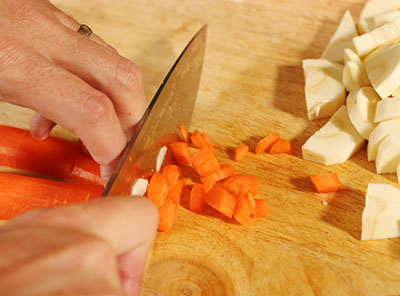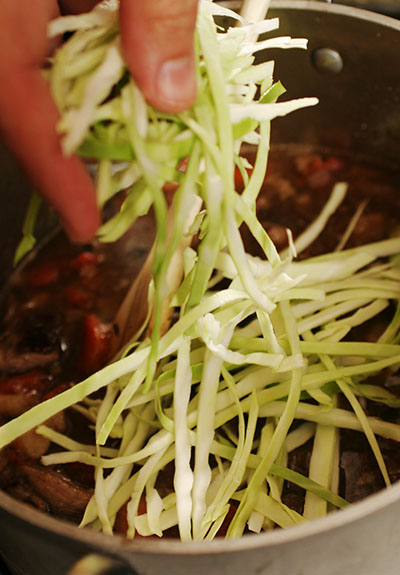Braised Oxtail Stew
I've been a braising madman this winter. Florida doesn't have the weather issues the rest of the country is experiencing right now, but winter is the season to braise -- slow cooked meat, with root vegetables and a kick of canned peppers. My heritage is Northern European -- Polish, German, Latvian, Russian (with an antipodal dip into Capetown, South Africa a few generations back). So economical cuts like oxtails are natural to me, because I've been eating oxtail soup every winter since I could hold a spoon. To me, oxtail soup/stew speaks of Poland, but when I lived in Atlanta, I found oxtails were a lot more culturally widespread than I thought. I bought some one winter from the local grocery, and the African-American cashier and I got into a discussion about the best way to cook oxtails, and compared childhood stories of cold nights and beefy stew. Since then, I've found that oxtails are also popular from Korea to Italy.
The oxtail is, indeed, meat from the tail of cattle. It may be an actual ox (usually a castrated bull), or these days, any cattle. It is high in gelatin, and usually cut into segments. It's highly prized for soups and stews as the slow cooking makes the meat tender, the gelatin provides a ton of body and succulence, and the meat and bones provide a deeply beefy taste.
My mother has honed her oxtail soup recipe for as long as I've been alive. It's my preferred comfort-food recipe, but rather than try to duplicate hers, I thought I'd play with the idea a little this last weekend, and I decided to to do a more continental-classic braised treatment, then simmer it into a stew. I got interrupted in my cooking, so I actually refrigerated the oxtails after the braise, then continued the stew the next day. This is no problem, and in fact, an enhancement when it comes to braised meat, and the stew probably benefited from the extra day of flavor.
So, here's a great winter meal, sure to warm up a chilly evening or two:

Braising is a wonderful blend of two types of cooking -- a hot sear to bring caramelized flavor, leading into a slow cooked simmer, to create wonderfully juicy and tender meat from tough cuts. To start, I used a couple pounds of oxtails, a couple parsnips, carrots, shallots, some veal stock, whole peppercorns, red wine, red wine vinegar, and some bottled cherry peppers.

The oxtails were seared in a pan over medium-high heat with some olive oil until browned on all sides.






Meanwhile, I peeled and rough-chopped the parsnips, carrots, and shallots.




Once the oxtails were browned, a touch more olive oil was added, then the vegetables were sautéed until caramelized with some whole garlic cloves.





Once the veggies were caramelized on the edges, I added a cup of red wine (a Cabernet Sauvignon), a cup of veal stock (or unsalted beef stock), a few tablespoons of red wine vinegar, some peppercorns, and a couple seeded cherry peppers.





After this was brought up to a gentle simmer, the oxtails were added back, and the whole pan was put into a preheated 275 degree oven. The idea is that the liquid is roughly halfway up the oxtails. If the liquid gets low, more stock, wine, or water can be added (whatever is on hand) to bring the liquid back up.


After an hour and a half, the oxtails were flipped and braised for another hour and a half.

At this point, I cooled them to room temperature, then put the whole pan into a bowl and stored in the fridge overnight. The next morning, there was a layer of solid fat over the oxtails and the vegetables that was easily removed.

After the fat was removed, I set the oxtails aside and picked out the majority of the carrots and parsnips by hand. What was left was a jelled stock mixture, with the cherry peppers and peppercorns mixed in. I forced the stock and braising liquid through a strainer to remove the peppercorns and cherry peppers, and added a cup of water to liquefy the stock a bit.


After simmering for an hour, the meat was completely and totally falling off the bone, which is perfect. I removed the oxtails and pulled the meat off, shredding into strips and discarding any fat or gristle. I added the meat back into the stew and froze the bones (to make stock at some other date).




After the meat was added back in, I took some canned tomatoes, seeded them, then tore them by hand into strips and added them to the stew.


Ten minutes before serving, I put some egg noodles to cook in some boiling water, and I chopped a half cup of cabbage (here's the Northern European twist) and shredded it, adding it to the stew. By the time the noodles were cooked, the cabbage was warmed and cooked, and yet still a bit crunchy, which gives a great texture to the stew. Salt and some cracked black pepper is added, to taste.



Plating is simple: a bowl of egg noodles, with stew poured over the top.

Deconstruction: What can I say? My blood sings for this stuff. The stew was thick -- the gelatin in the oxtails does a good job of thickening without needing flour or other liaisons, especially after three hours of braising and a couple more of stew simmering. The vegetables absorbed the braising flavors, from the beefy meat to the zing of cherry peppers. The cabbage was crispy, and the noodles were starchy enough to bind the taste together (and sop up the liquid). It was a hearty meal.



